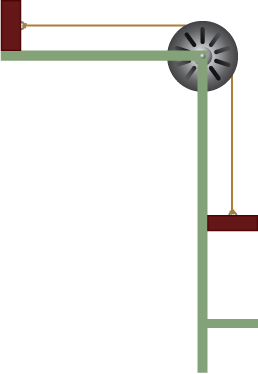Module 3—Effects of Force on Velocity
 Module Summary
Module Summary
Isaac Newton is one of the major figures in the history of dynamics. You’ve seen his name throughout the module, Effects of Force on Velocity. Most of the work you’ve completed revolved around Newton’s laws of motion, which are stated here in a modern translation:
- Newton’s First Law: The Law of Inertia: A body at rest remains at rest. A body in motion continues to move in a straight line with a constant speed (e.g., constant velocity) unless an external, unbalanced force acts on it.
- Newton’s Second Law:
 : The rate of change of velocity of an object is proportional to, and in the same direction as, the unbalanced force acting on it.
: The rate of change of velocity of an object is proportional to, and in the same direction as, the unbalanced force acting on it.
- Newton's Third Law:
 : For every action force, there exists a reaction force that is equal in magnitude but opposite in direction.
: For every action force, there exists a reaction force that is equal in magnitude but opposite in direction.
As you were working in this module, you were asked to keep the following questions in your mind. Did you see how your studies helped you answer them?
- How is the motion of an object affected by forces applied to it?
- How do unbalanced forces affect the motion of an object?
- How do Newton’s laws help explain why motion occurs?
- How do you find a reaction force?
- How does friction affect moving objects?
- How does friction affect making an object move?
- How do free-body diagrams, vector analyses, and Newton’s second law help solve moving-object problems?
Newton’s first and second laws explain the vector motion of an object and can be applied to understand and solve problems related to moving objects, like a child climbing to the top of a slide. Newton’s third law explains how two bodies interact with an action-reaction force pair.
Since there are many forces that can act on a single object, a way to keep track of them all is needed. You’ve used free-body diagrams as a way to keep track of multiple forces acting on a single object. They are used along with Newton’s second law to find equations that explain what will happen next.
When a child sits at the top of a slide, what forces are being applied that you know about but that the child isn’t aware of? One is the normal force supporting the child’s body where it is in contact with the slide. On a flat, horizontal surface, this is just the child’s weight, which from Newton’s second law is ![]() .
.

On sloped surfaces, you have to find the portion of the weight that acts perpendicular to the surface. In the accompanying diagram, the normal force corresponds to the blue line in the triangle. You can find it from the weight (the black line) using the equation ![]() .
.
Another force the child might not think of is friction. This force opposes the relative motion of two surfaces that are in contact. Friction is a tricky concept—it seems to decrease when an object finally starts moving. That’s why you studied both moving (kinetic) and stationary (static) friction. The following equations relate the normal force and the frictional forces.

You’ve also used Newton's second law to find the acceleration an unbalanced force gives an object. Often, you had to calculate a net force, which is the vector sum of all the forces acting on an object, to find the acceleration. Do you think a youngster pushing herself forward to start down a slide thinks of all of this?
You’ve probably used the following processes when you were asked to work with forces acting on objects.

For one- and two-dimensional forces acting on a single body:
- Make a free-body diagram.
- Find the total net force acting along each axis using components, if necessary.
- Draw a vector diagram using the total force acting along each axis.
- Find the total force by adding the force on each axis as vectors.
- State the net force and acceleration.
For connected objects:
- Define the directions using a coordinate axis.
- Construct a free-body diagram for each body.
- Generate an equation for the net force and acceleration of each body.
- Combine the equations.
- Manipulate the equations to solve for the acceleration and/or tension in the system.
With these tools available to you, you will be beginning to study another of Newton’s contributions to physics, namely the study of gravity.
Module Assessment
The assessment for Module 3 consists of five (5) assignments:
- Module 3: Lesson 1 Assignment
- Module 3: Lesson 2 Assignment
- Module 3: Lesson 3 Assignment
- Module 3: Lesson 4 Assignment
- Module 3: Lesson 5 Assignment